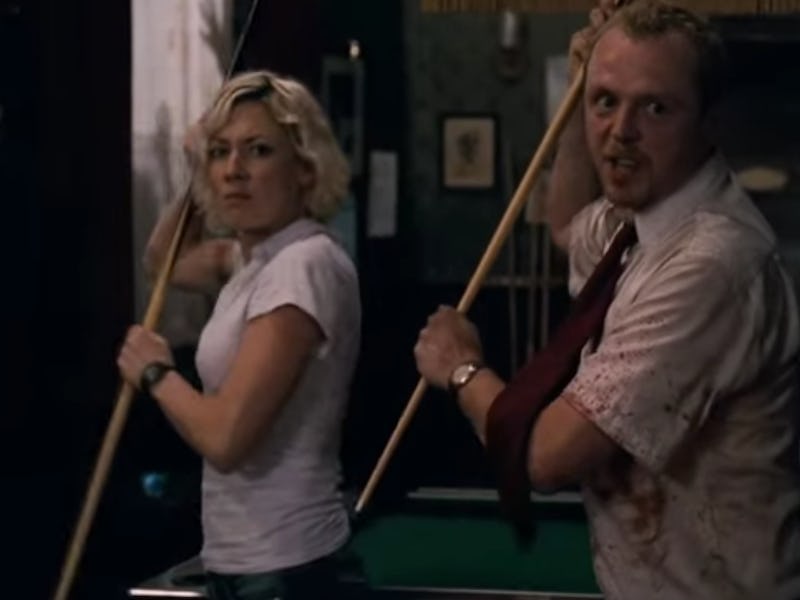Analyzing the 'Shaun of the Dead' Beatdown Scene Set to "Don't Stop Me Now"
Source music is a powerful narrative tool and few films have used it quite as effectively as 'Shaun of the Dead.'

Music plays a pivotal role in almost everything we watch. Whether it’s in the form of carefully curated pop tracks, throwback jams, or original scores, music has the power to shape narrative interpretations and influence the way in which an audience experiences a scene.
When we talk about film sound, it can be helpful to split the sound that we hear in the course of the narrative into two distinct categories: diegetic and non-diegetic sound.
Diegetic sound is anything that happens within the world of the film: dialogue, footsteps, car horns, or slamming doors. Non-diegetic sounds are noises that don’t exist in the world of the film and are not heard by characters — narration and sound effects with no in-world source.
As we extend this idea to music, diegetic music (or “source music”) comes from an onscreen source inside of the world of the film: characters listening to the radio, playing instruments, or attending a concert. Non-diegetic music exists to the audience’s ears, but not to the characters’ — think cinematic scores or songs played over montages. There are dozens of iconic examples of using source music throughout film history, but the standouts are transformative in their scenes, shaping narratives around their music and impact the world inside of and beyond the film.
Let’s take a look at an enduring example of diegetic music and a perennial fan fave: The Shaun of the Dead scene in which Simon Pegg and his rag-tag gang of survivalists beat a zombie to the tune of Queen’s “Don’t Stop Me Now.”
To be clear, this scene from Shaun of the Dead is an extreme example of source music. Not only does the song choice exist in the world of the film, but it also serves as the rhythmic backbone for the scene.
Shaun’s fight with the zombie is essentially choreographed to the song and many of the major comedic hits come either in reference to the music (“Kill the Queen!”) or alongside major beats.
It’s important to note that this use of source sound doesn’t just boil down to putting a widely recognized song on the jukebox and placing some well-timed blows to a reanimated flesh-eating corpse. Shaun of the Dead’s use of source music here is a central element to Edgar Wright’s oft-noted visual comedy.
Take the pool cues, for example: When Shaun throws them, the (exaggerated) sound effect gives us some rhythmic interest. Then, when they raise their cues in unison, it sets up the tempo increase. Finally, the characteristic “thwap” and “smack” of the cues take on the drumbeat rhythm.
There’s also David and the switches. In a brief but effective sequence, he flips the switches on the fusebox in time with the song and grounds the tune in the scene even further. Immediately after, the zombies shatter the glass and take us into a new verse.
After that, we’ve got Liz hoisting the fire extinguisher with some beautifully timed hits to Freddie Mercury’s “oh oh oh oh oh”‘s, followed by the brilliant detonation of the extinguisher on “explode.”
And, of course, when Shaun catches a dart to the head, he sets up one hell of a signature Mercury howl with one of his own.
Without “Don’t Stop Me Now,” this scene is fundamentally altered. Even with another Queen song —or something with a similar tempo and sonic signature — the scene isn’t the same. That’s what outstanding uses of source music is all about: making intentional storytelling decisions with music, a device that’s sometimes overlooked.
Source music is used with varying degrees of effectiveness, but this particular implementation is vital and transformative in the scene. It’s not just any song that comes on the jukebox, but one that’s comedic in context and gives its own narrative cues. Furthermore, the scene doesn’t just use the song, it’s built around it.
This isn’t a case of using source music as a crutch to introduce levity or sadness or revelation at the hands of a song — that’s lazy storytelling. Instead, this scene makes full use of the song choice and makes it feel indispensable to the action.
We’re trapped in a pub trying to be quiet so as not to attract the attention of the zombie hoard outside, and this damn jukebox starts mercilessly blasting an anthemic Queen song. It’s certainly a clever comedic turn, and the joke levels up as the source music carries the comedy into the physical realm with the fight sequence.
There are so many coordinated elements pulled off with such precision in this sequence that you’re likely to notice something new each time the first few times you watch it, and that’s whats made it so iconic and one of the premiere examples of source music in film. Source music is a powerful tool, and this scene from Shaun of the Dead is a masterclass.